Mating behaviour and silk use in (some) mygalomorphs
So in my ‘intro to spider systematics’ post, I wrote that most of the Mygalomorphae are tarantulas. This is not actually true when you consider total numbers of species. Of the 2775 mygalomorph species (in 16 families), 950 species are in the family Theraphosidae (tarantulas), so that’s actually only about 34%. I probably should have said that the tarantulas are the most common mygalomorphs (and the ones people are generally most familiar with). Theraphosidae definitely wins the prize for the largest mygalomorph family, though. The next most speciose family is Nemesiidae, with 364 species.
I also implied that the Mygalomorphae aren’t all that sophisticated when it comes to silk use. Whereas the Araneomorphae have the ability to spin several different kinds silk specialized for particular functions, the Mygalomorphae produce only one general purpose silk. This is not to say, however, that they have not come up with some marvellous silk-based innovations!

In the centre of the vegetation in the foreground, you may spy the mouth of a well camouflaged silk-lined ‘turret’ built by a mygalomorph in the family Antrodiaetidae. (Photo by M. Hedin, licensed under CC BY 2.0)
Mygalomorphs have poor vision, so they must rely on chemical (smell or taste), vibratory, and tactile senses. It was traditionally thought that these relatively ‘primitive’ spiders had simple sexual communication systems. However, in their recent review in the Journal of Arachnology, Ferretti and coauthors argue that the sexual behaviour of mygalomorphs actually involves some quite elaborate courtship displays and complex mechanisms of communication. This post will highlight the 6 mygalomorph families described in the paper, most of which use silk in various ways for both prey capture and sexual communication.
Now, as a general rule, spiders are predatory, and mygalomorphs are no exception. They’re pretty keen to snap up anything that blunders into their field of vibratory perception, even if it’s another spider. The main functions of courtship behaviour in mygalomoprhs are mate recognition, orientation and synchronization of sexual behaviour, and suppression of non-sexual responses. Females must advertise their location and receptivity, and males must somehow signal “male, not meal!” to their potential partner. This can be tricky when the stage on which the male must show off his desirability as a mate is the same one that the female uses to detect prey. We’ll see what kinds of things these spiders get up to in order to make it to the finish!
Antrodiaetidae: turret mygalomorphs
Antrodiaetids live underground in silk-lined burrows. The burrow entrance is extended with a turret made from silk, soil, and plant material that blends in beautifully with the surrounding substrate. The spider waits for prey just out of sight inside the tube, where she can detect and quickly respond to vibrations produced by insects brushing against the litter encasing the turret. Males detect the female’s location using pheromones – chemicals acting as olfactory personal ads – on the silk that lines her home.
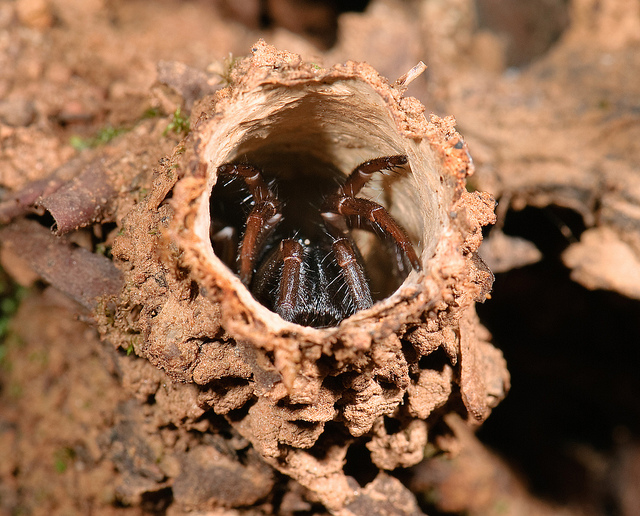
Antrodiaetus riversi (Antrodiaetidae) in feeding position in turret (Photo by M. Hedin, licensed under CC BY 2.0)
Dipluridae: funnel-web mygalomorphs
The diplurid funnel-web is a horizontal silk sheet leading to a tubular retreat in a crevice or perhaps under a stone or log. From this silken hideout, the spider detects vibrations produced by prey passing over her sheet web. The female’s funnel-web also forms the dance-floor for the male’s vibratory courtship display. The male’s courtship signals are transmitted to the female through the silk sheet. Typically, she does not respond, which is great news for the male! Presumably his pedipalp drumming and many legged tap-dancing is quite distinct from prey vibrations, inhibiting the predatory tendencies of the female.
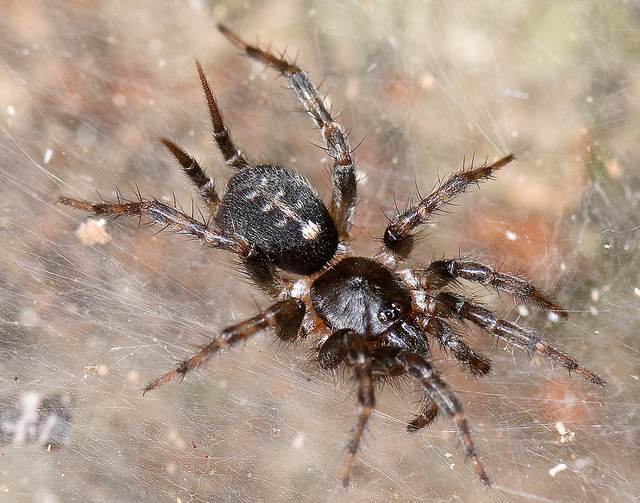
Ischnothele caudata (Dipluridae) female in her funnel web. Note the elongated spinnerets characteristic of this family. (Photo by M. Hedin, licensed under CC BY 2.0)
Mecicobothridae: sheet-web mygalomorphs
Mecicobothriidae is a family containing nine species of small spiders that build sheet-webs on the soil. In Mecicobothrium thorelli, chemical and/or tactile signals on the female’s silk trigger the male’s courtship display. Like in the diplurids, the male’s dance moves transmit vibrations through the silk to the female, who sits passively in judgment. The receptive female apparently enters a cataleptic state, allowing the male to haul her around the web and manoeuvre her into just the right position. It’s not quite as easy as all that for the male, though. In order for a successful copulation to occur, the chelicerae of the spiders must interlock in a very specific way. If the couple is disturbed while in copula, or there are any difficulties disengaging from this toothy embrace, it’s game over for the male, and dinner time for the female. Once the deed is done, a successful male will stick around on the female’s web, attacking any other males attempting to try their luck with the female. This ‘mate guarding’ behaviour is very unusual among mygalomorphs.
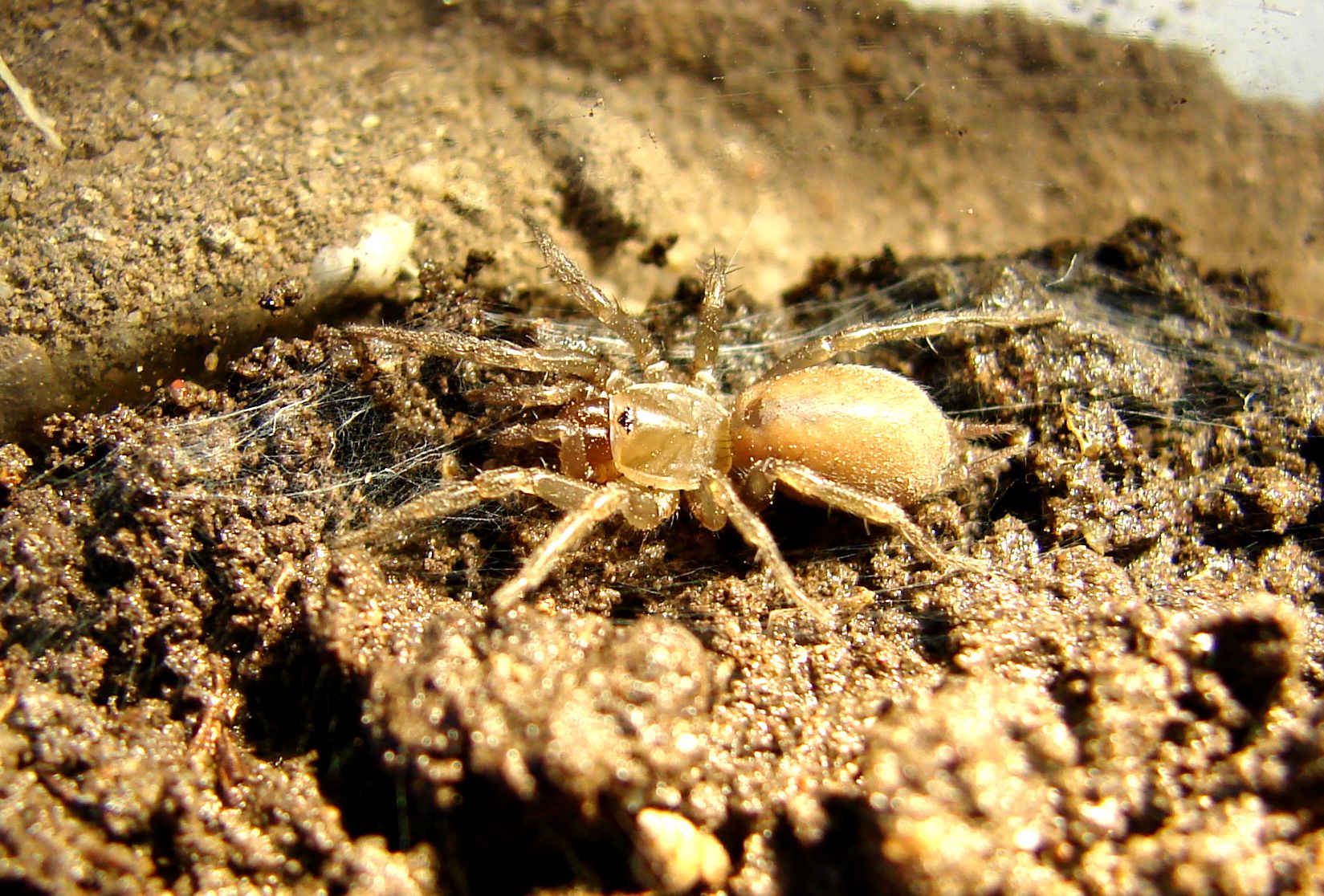
Female Mecicobothrium thorelli (Mechicobothriidae) on her sheet-web. (Photo credit: Gabriel Pompozzi)
Theraphosidae: tarantulas
Theraphosids often live in silk-lined underground burrows, or silken retreats under rocks and vegetation. Sometimes they even build their tube-like homes in trees. Pheromones on the silk allow males to find and recognize females, and also trigger courtship behaviour. Males transmit species-specific vibratory courtship signals through the ground, to the female listening in her burrow. These seismic love songs can be detected by females at a distance of more than one metre. In Avicularia avicularia, the female actively responds, tapping her first pair of legs and pedipalps on the substrate. These good vibrations tell the male she is receptive to his advances, and may also help the male orient toward her.
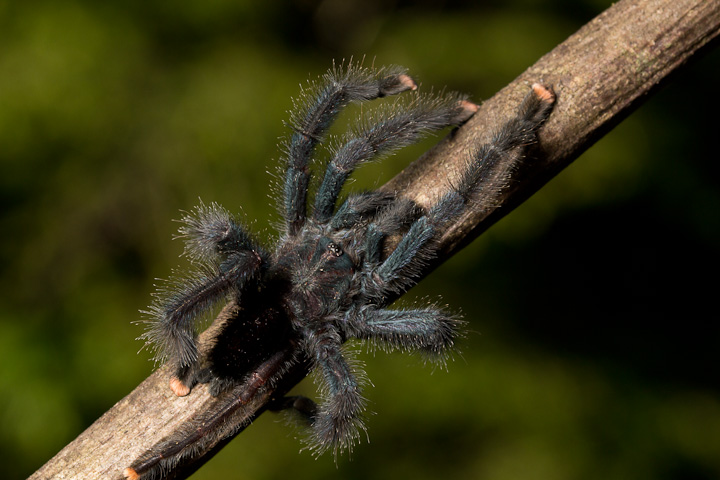
Immature Avicularia avicularia (pinktoe tarantula) (Photo credit: Sean McCann)
Nemesiidae: tube-trapdoor mygalomorphs
Nemesiids generally live in silk-lined burrows, sometimes finished with hinged, camouflaged trap-doors. Male courtship includes scratching and tapping with the legs on the ground, often at a distance from the female’s burrow entrance, suggesting that this is another form of long-distance seismic communication. While most female mygalomorphs remain relatively passive throughout courthship and copulation, Acanthogonatus centralis females jerk violently, twitching all their legs and pedipalps. This enthusiastic behaviour may stimulate the male to begin copulation.
Microstigmatidae
The family Microstigmatidae contains 16 species of tiny spiders (males are only 1-3 mm long!). This is one family that apparently makes minimal use of silk. Xenonemesia platensis males only begin courtship after making direct contact with the female’s body. The male’s courtship behaviour includes quivering with the first two pairs of legs. The female, if she is receptive, responds by moving into a mating posture with her genital area exposed, allowing the male to clasp her pedipalps and chelicerae with his first legs.
This clasping of the female’s chelicerae by the male is common in mygalomorphs; in many species males have specialized structures on their legs that facilitate the embrace. Some researchers think it may be a way of restraining a potentially lethal female, keeping her fangs at leg’s reach. However, the fact that female catalepsy during copulation is also widespread sheds some doubt on this interpretation. Alternatively, it may be a more ‘symbolic’ form of bondage akin to the bridal veil in some araneomorphs. The tactile stimulation associated with the male’s clasping may in fact cause the female to become quiescent.
Throughout copulation, the Xenonemesia platensis male continues his tactile courtship, tapping and scraping his second pair of legs against the female. It’s possible that this copulatory courtship persuades the female to use his sperm over that of competitors, but more work needs to be done to test this hypothesis.

Mating Xenonemesia platensis (Microstigmatidae). The male has the female’s pedipalps and chelicerae clasped in his first pair of legs, while he uses his second pair of legs to beat and scrape the female’s coxae (leg segments closest to the body) (Photo credit: Gabriel Pompozzi)
The mygalomorphs may all look fairly similar, but they have surprisingly diverse habits, and use their multi-purpose silk in clever ways. Their sexual communication is most certainly not simple, incorporating multiple signaling modalities. Just as with most araneomorphs, good vibrations and sexy scents are the key!
Growing evidence suggests that contact sex pheromones associated with female silk are common in mygalomorphs (as they are in araneomorphs). Sex pheromones have also been implicated in the sexual communication systems of some spiders in the Mesothelae, suggesting that chemical communication was acquired early in the evolutionary history of spiders.
This story of mygalomorph mating also highlights the fact that female spiders in general are not simply passively waiting for marauding males to stumble across their doorsteps. On the contrary, they actively advertise for a mate, sometimes participating in a vibratory signaling ‘conversation’ with courting males, and likely judge a suitor’s quality both before and during copulation.
The private lives of spiders never cease to fascinate!
References, resources, and acknowledgements:
For a wonderful read about the evolution of spiders and their silk, including lots more information that I didn’t include about the fascinating habits of mygalomorphs, I highly recommend Leslie Brunetta and Catherine Craig’s book Spider silk: Evolution and 400 Million Years of Spinning, Waiting, Snagging, and Mating (an excellent gift idea!).
Ferretti, N., Pompozzi, G., Copperi, S., Gonzalez, A., & Pérez-Miles, F. (2013). Sexual behaviour of mygalomorph spiders: when simplicity becomes complex; an update of the last 21 years. Journal of Arachnology, 16(3), 85–93.
Ferretti, N., Pompozzi, G., Copperi, S., Pérez-miles, F., González, A., & Pe, F. (2012). Copulatory behavior of Microstigmatidae (Araneae: Mygalomorphae): a study with Xenonemesia platensis from Argentina. Journal of Arachnology, 40(2), 252–255.
Costa, F. G., & Perez-Miles, F. (1998). Behavior, life cycle, and webs of Mecicobothrium thorelli (Araneae, Mygalomorphae, Mecicobothridae). Journal of Arachnology, 26, 317–329.
Special thanks to Gabriel Pompozzi for allowing me to use his photographs of Xenonemesia platensis and Mecicobothrium thorelli. Check out more of his fantastic images of mygalomorphs here.
I am also very grateful to Marshal Hedin for generously making his photographs available under creative commons licenses. He has some really wonderful sets of shots of several mygalomorph families on flickr.

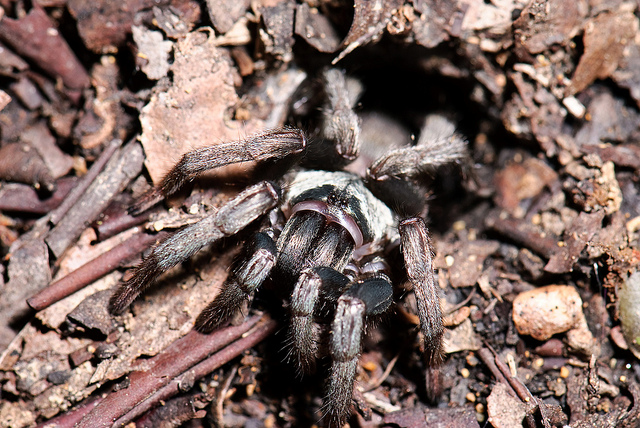
Pingback: Morsels For The Mind – 20/12/2013 › Six Incredible Things Before Breakfast
Pingback: A tiny tarantula | spiderbytes